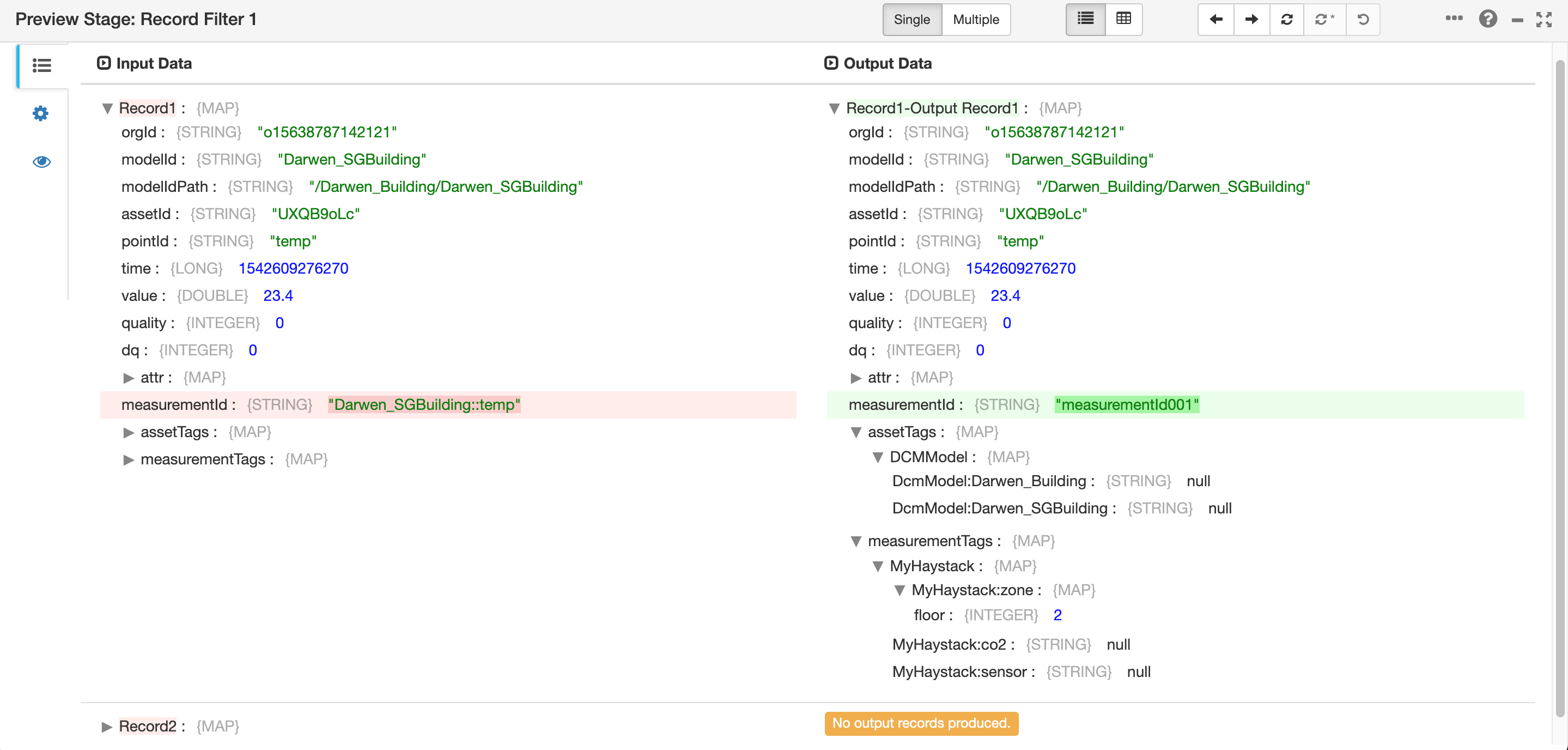Record Filter¶
Supports filtering of input data based on user-configured expressions.
Configuration¶
The configuration tabs for this stage are General, Basic and Input/Output.
General¶
Name |
Required? |
Description |
|---|---|---|
Name |
Yes |
The name of the stage. |
Description |
No |
The description of the stage. |
Stage Library |
Yes |
The streaming operator library to which the stage belongs. |
Required Fields |
No |
The fields that the data records must contain. If the specified fields are not included, the record will be filtered out. |
Preconditions |
No |
The conditions that must be satisfied by the data records. Records that do not meet the conditions will be filtered out. For example, |
On Record Error |
Yes |
The processing method for error data.
|
Basic¶
Name |
Required? |
Description |
|---|---|---|
Quality Filter |
No |
Filter the data according to the data quality. Only records that meet the quality conditions will be processed by this stage. |
Filter Expression |
Yes |
The data is filtered according to the configured expression, see below for the specific expression syntax: Filter Expression Syntax Summary |
Output Measurement ID |
Yes |
Note: If a data satisfies multiple Filter Expressions, the record will be output multiple times and the mesurementId of the output record will be replaced with the configured Output Measurement ID. replaced accordingly |
Filter Expression Syntax Summary¶
To support more flexible and convenient filtering of data, the Filter Expression configuration supports the use of Aviator Script to filter the input data. Here is a brief description of the syntax and functions for this operator usage scenario, for further details, please refer to Aviator Script Documentation.
Basic Types and Operations¶
Type |
Description |
Sample |
|---|---|---|
Number |
Can be integer, floating point, etc. |
123,3.1415 |
String |
Consecutive characters enclosed in single or double quotation marks |
‘hello’,”world” |
+, -, *, / |
Add, subtract, multiply and divide, + can also be used to splice strings |
1+1.2, 5/2, ‘ab’ + ‘c’ |
<, <=, >, >=, ==, != |
Comparison Operators |
3 != 1 |
&&, ||, ! |
Logical with/or/without operators |
true && false |
Variables¶
Generally, variables are not created directly in the Filter Expression configuration; the Record Formatter algorithm already converts the input data into an object with the name record for use.
Built-in Objects |
Description |
|---|---|
record |
The input data is converted into a Map object to be passed into the expression execution context, which can be accessed by record as a variable name. Note: For a batch of input data, record represents only one of the data, and the expression will act on each record of the batch in turn. |
Since record is a Map object, Aviator provides a syntax for accessing the contents of the Map object in addition to using functions. Here is a brief example.
Syntax |
Description |
|---|---|
record.a.b |
Indicates access to the value of the b attribute in the a attribute on the variable record |
#record.a[1].b |
indicates access to the b attribute value of the 2nd (starting from 0) object in the array a on the variable record, note: if the variable in the access path is an element of the array/List, you need to start with the # |
#`record.name:a.b` |
indicates access to the value of the b attribute in the name:a attribute on the variable record. Note: If the name of the accessed attribute/variable contains special characters, it needs to be surrounded by # plus `` |
Common Functions¶
There are many functions built into Aviator Script, here are only the common functions used to configure Filter Expression, for more functions please refer to Aviator Script Documentation.
Functions |
Description |
|---|---|
seq.contains_key(map, key) |
Get the value of the corresponding element from a list, array or map, where element is the index position of the element (starting from 0) for lists and arrays, and element is the key for maps |
seq.get(map, element) |
Returns true when there is a key in the map (which may be null); for arrays and chained tables, the key can be index, and returns true when index is in the valid range [0..len-1], otherwise returns false |
string.startsWith(s1,s2) |
Returns Boolean if string s1 starts with string s2. |
string.endsWith(s1,s2) |
If or not the string s1 ends with the string s2,return Boolean |
Sample¶
For a record like the following:
{
"orgId": "o15638787142121",
"modelId": "Darwen_SGBuilding",
"modelIdPath": "/Darwen_Building/Darwen_SGBuilding",
"assetId": "UXQB9oLc",
"pointId": "temp",
"time": 1542609276270,
"value": 23.4,
"quality": 0,
"dq": 0,
"attr": {},
"measurementId": "Darwen_SGBuilding::temp",
"assetTags": {
"DCMModel": {
"DcmModel:Darwen_Building": null,
"DcmModel:Darwen_SGBuilding": null
}
},
"measurementTags": {
"MyHaystack": {
"MyHaystack:zone": {"floor": 2},
"MyHaystack:co2": null,
"MyHaystack:sensor": null
}
}
}
Filter Expression Sample |
Description |
|---|---|
|
First, determine whether record.assetTags.DCMModel This Map object contains a Key with the name DcmModel:Darwen_SGBuilding, if true, continue to determine whether record.measurementTags.MyHaystack: zone.floor is greater than 1, both are true, then return true |
Output Results¶
Output Example¶
Configuration information

